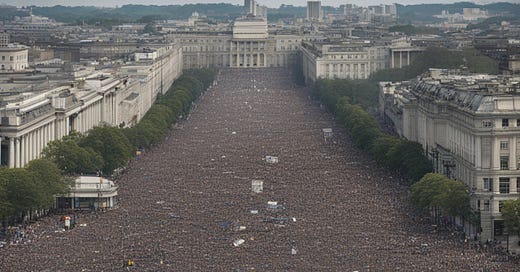Do Mass Gatherings Actually Help?
Can we know whether there's enough value in stacking public protests to justify the investment?
A lot has been said about whether or not “yeshivishe” people should have attended Tuesday’s March for Israel rally in Washington. I don’t have anything interesting to add to that conversation. But I haven’t seen anyone addressing a different point that might be even more important: is there any value in such gatherings? Or, to put it a bit more precisely, is there enough value to justify the time, energy, and significant expenses involved?
Perhaps we can learn from the historical record.
There’s the Gemara (Rosh Hashanah 19a) where a certain well-connected woman advised Rabbi Yehuda ben Shamuah to make their case by crying out at night -presumably somewhere in Rome where they’d have a chance of being heard. While the Gemara concludes that the exercise was successful, we are told too little about how it worked to draw useful conclusions.
There was also the Rabbis’ March on Washington in 1943, where 400 (mostly Orthodox) rabbis traveled to the White House in the hope of convincing President Roosevelt to direct Allied resources to intercede in the Holocaust. Roosevelt, on the advice of his (non-Orthodox) Jewish advisors, chose to ignore the delegation. No official, direct change in government policy occurred, but it is possible that the march had an indirect influence on the later decision to create the War Refugee Board a few months later.
But given how they mostly involve rabbis, I don’t think those two examples are helpful for us.
Instead, I’ll cast my net a bit more broadly and see what we can learn from more modern protest movements. Of course it’s obvious that factors like ethnicity, political context, and each protest’s actual goals will make useful comparisons difficult. But if we could distill the collected experiences of many, many protests, perhaps some patterns might appear.
As it turns out, the Carnegie Endowment for International Peace has a Global Protest Tracker page containing data representing nearly 600 protests around the world in the years since 2017. Each protest entry is defined by a number of useful metrics, including how many people were there at the protest’s peak and whether the protest led to a significant outcome.
First, though, I should explain that we’re looking for evidence suggesting that the chances of success justify the effort and expense (and risks) of taking hundreds of thousands of people away from their daily lives. Or, put a different way, would a protest involving 5,000 people accomplish as much (or as little) as one that attracts a crowd of 200,000?
Once I’d downloaded the full Protest Tracker dataset, I got to work looking for a correlation between protest size and effectiveness. I first calculated the Pearson Correlation Coefficient for the entire dataset between the event size and success columns. If success was significantly more likely as the protest size grew, then the coefficient number we’d get back would be close to 1.0. If there was absolutely no correlation - i.e., success was no more likely with big crowds than with small - then the number would be close to 0.0.
As it turns out, the Coefficient I got was around 0.12, suggesting a very low connection between size and success.
I then ran the same calculation on a smaller subset of the data: just the 59 protests that attracted at least 100,000 participants. I wanted to see if, say, 200,000 people were more effective than 100,000. This time the coefficient value was around 0.32 - a bit higher than before, but still quite a weak relationship.
Another way of thinking about that would be to note that the “success rate” of all the 592 protests covered in the Carnegie data was 26%, while the success rate of just the 59 largest events was 35%.
Those numbers obviously aren’t compelling enough to draw any firm conclusions, but I would suggest that they’re something to keep in mind.
And I would also suggest that carefully defining our goals could be at least as helpful. Many protests in the West aim to directly influence government legislation or policy. In those terms, the historical success record has been spotty.
But sometimes a large public event can lead to a more subtle shift. Consider how Dr. Martin Luther King’s landmark 1963 March on Washington for Jobs and Freedom might not have accomplished all of its immediate goals but, over time, Dr. King’s “I have a dream” speech certainly enjoyed a measurable and long-lasting influence on public perceptions and attitudes.
Perhaps such considerations should also be part of the mix for both planning and evaluating protests.
I would add that I’m certainly not the first person to ask these questions. In fact, there’s been serious research into the impact of larger numbers on protest outcomes.





I think that your data exercises just demonstrate that despite how much we tell ourselves that our decisions are based on "science and data", it just ain't the case for 99% of the actions we take. Most of our actions are based on intuitions, experience, and reasoning. Data analysis is valuable for refining our reasoning, and in some cases overturning it, but let's not pretend that it's the be all and end all. In the end of the day, it's the most natural, intuitive thing in the world to make your voice heard, just like you are doing here on your blog, and nothing accomplishes that better than a huge rally.